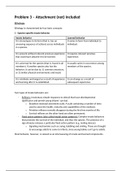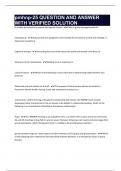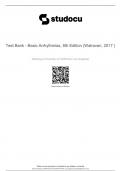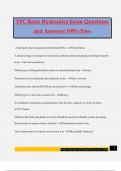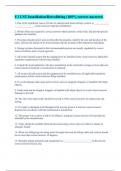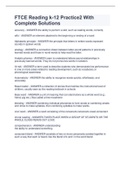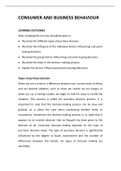Life Sciences Paper 2 Notes
DNA: Code of Life - 18%
● DNA: location, structure and functions
● DNA replication
● DNA profiling
● RNA: location, structure and function
● Protein Synthesis
Meiosis - 14%
● Meiosis - The process
● Importance of meiosis
● Abnormal meiosis
● Comparison of mitosis and meiosis
Genetics and Inheritance - 32%
● Concepts in inheritance
● Monohybrid crosses
● Sex determination
● Sex-linked inheritance
● Blood grouping
● Dihybrid crosses
● Genetic lineages/pedigrees
● Mutations
● Genetic engineering
● Paternity testing
● Genetic links
Evolution - 36%
● Evidence for evolution
● Variation
● Origin of an idea about origins
● Lamarckism
● Darwinism
● Punctuated equilibrium
● Formation on new species
● Mechanism of reproductive isolation
● Evolution in present times
● Evidence of common ancestors for living hominids, including humans
● Out of Africa hypothesis
,DNA: The Code of Life
Key Terminology:
Nucleic acid A type of organic compound
Monomer A building block
Nucleotide The monomer which forms DNA and RNA
DNA Deoxyribonucleic acid is made up of nucleotides
- Nitrogenous bases adenine, thymine, guanine and cytosine
- Carries the genetic code for protein synthesis
Nuclear DNA DNA found in the nucleus
Extra- nuclear DNA DNA found outside of the nucleus: mitochondrial and chloroplastic DNA.
Double helix The shape of DNA consists of two strands joined together and twisted spirally
Hereditary Genetic information passed on from parent to offspring
RNA RNA consists of nucleotides.
- Nitrogenous bases adenine, uracil, guanine and cytosine
Messenger RNA mRNA carries the code for protein synthesis from DNA to the ribosome
Ribosomal RNA rRNA forms ribosomes which are the site of protein synthesis
Transfer RNA tRNA brings amino acids to the ribosome to form the protein
Amino acids Monomers of proteins
Base triplet Three nitrogenous bases one after the other on DNA
Transcription 1st stage of protein synthesis – mRNA formed from DNA carrying code for the
protein to be made
Translation 2nd stage of protein synthesis – amino acids combine to form a protein
Codon 3 nitrogenous bases one after the other on mRNA – these are complementary to the
triplet on DNA
Anti-codon 3 nitrogenous bases one after the other on tRNA – these are complementary to the
codon on mRNA
,Introduction:
Revision of the structure of a cell:
● Cytoplasm
○ The base substance in which the organelles
of the cell are suspended.
○ A watery substance and allows for metabolic
reactions to take place.
● Ribosomes
○ Small, round organelles which are mainly
found attached to the endoplasmic reticulum or are free-floating in the cytoplasm.
○ Also found inside other organelles like the chloroplast and mitochondria but in smaller numbers.
○ The site of protein synthesis and they consist of RNA and protein.
● The Nucleus
○ The double nuclear membrane – encloses the nucleus and contains small pores to allow for the
passage of substances in and out of the nucleus
○ The nucleoplasm – a jelly-like fluid within the nucleus
○ The nucleolus – a dark body suspended in the
nucleoplasm which contains free nucleotide bases
and produces ribosomes
○ The chromatin network – found in the nucleoplasm:
contains the DNA which forms the chromosomes
containing the genetic code of a person / organism
Two types of nucleic acids: DNA and RNA:
● DNA (Deoxyribonucleic Acid)
○ A molecule that carries genetic info
○ Found inside the nucleus of almost every cell in our bodies or mitochondrion
○ Protected by nucleus besides when the cell replicates as the nucleus disintegrates
○ Made from 2 strands of polynucleotides - double helix
● RNA (Ribonucleic Acid)
○ A molecule that carries genetic info
○ Can move from inside of the nucleus into the rest of the cell
○ Found inside nucleus and on Ribosomes in Cytoplasm
○ Made from 1 strand
● DNA/RNA = polymer ; nucleotides = monomer
DNA:
● Location
○ Present in the nucleus (nuclear DNA) – makes up genes on chromosomes
○ Present in mitochondria (mitochondrial DNA)
○ Present in chloroplasts (plants)
● Discovery of DNA:
○ Rosalind Franklin and her assistant Maurice Wilkins researched the structure of DNA using X-rays
○ Watson and Crick proposed a 3-D double helix model for DNA after seeing Franklin’s images
○ Watson and Crick received the Nobel Prize for the discovery of the structure of DNA, and Wilkins
received an award for his X-ray photography. Franklin had died of cancer.
, ● Structure
○ The natural shape of the DNA molecule is a double helix that
surrounds histones (proteins)
○ Each strand of the helix is made up of a sequence of DNA
nucleotides
● Components of DNA nucleotide
○ Three components of a DNA nucleotide:
○ Nitrogenous bases linked by weak hydrogen bonds:
■ Four nitrogenous bases of DNA: adenine (A), thymine
(T), cytosine (C), guanine (G)
■ Pairing of bases in DNA occur as follows: A: T and G: C
○ Sugar portion - deoxyribose in DNA
○ Phosphate portion
● Function
○ DNA makes up genes which carry hereditary information
○ DNA contains coded information for protein synthesis
DNA replication:
● DNA replication - The process through which DNA makes an
identical copy of itself.
● This occurs during interphase of the cell cycle in the nucleus.
● Process:
○ The DNA double helix uncoils and unzips and the weak
hydrogen bonds between the nucleotides break
○ Two strands of DNA either side (exposed) act as a template
○ Free nucleotides (nucleoplasm) will fit themselves to their
complementary base pairs on either side
○ New deoxyribose sugars and phosphate groups bond to
the new bases
○ Hydrogen bonds will reform, each strand recoils and the
double helix reforms
○ There is now two, new identical DNA molecules, consisting
of one original strand and one new strand
● DNA replication is important for cell division
○ It allows each chromosome to be copied so that each new identical daughter cell produced contains
the same number and type of chromosomes
● DNA replication also introduces variation through mutation
○ Errors that occur during DNA replication may sometimes lead to mutations (a change in the
nitrogenous base sequence)
● If the incorrect nitrogen base attaches to the original strand and a nitrogen base is added or deleted
○ The sequence or order of the bases changes on the new DNA molecule
○ Resulting in a change in the gene structure
,DNA profiling:
● A DNA profile is a pattern produced on X-ray film.
● This pattern consists of lines which are of different lengths and thicknesses and in different positions
● All individuals, except identical twins, have a unique DNA profile.
● DNA profiles are used to:
○ Identify crime suspects in forensic investigations
○ Prove paternity (father) and maternity (mother) (biological parents)
○ Determine the probability or causes of genetic defects
○ Establish the compatibility of tissue types for organ transplants
○ Identify relatives
○ Identify military personnel missing in action
○ Identify people wounded beyond facial or dental recognition in car accidents, fires, terrorist attacks,
or who have decomposed beyond recognition
● DNA profiling is generally accepted as being extremely reliable.
● The interpretation and comparison of profiles should however be approached with caution, for the
following reasons:
○ Humans interpret the results which means mistakes could be made
○ The method of profiling may be different in different laboratories producing inconsistencies
○ Only a small piece of DNA is used in profiling, so the profile might not be 100% unique to a
particular individual
○ DNA profiling is expensive and therefore not readily accessible to those who cannot afford it,
particularly in criminal cases
○ DNA profiles may reveal information about a person which could be used against them in a
prejudicial way. For example: being HIV positive or having genetic abnormalities may lead to
insurance companies not covering a person or prejudice in the courtroom
RNA:
● Location
○ mRNA is formed in the nucleus and functions on the ribosome
○ tRNA is located in the cytoplasm
○ rRNA is found in the ribosomes in the cytoplasm of the cell.
● Structure
○ A single-stranded molecule consisting of nucleotides
● Components of nucleotide
○ Nitrogenous bases
○ Four nitrogenous bases of RNA: adenine (A), uracil (U), cytosine (C),
guanine (G)
○ Sugar portion - ribose in RNA
○ Phosphate portion
● Function
○ Plays a role in protein synthesis
, Comparison of DNA and RNA:
● Similarities:
○ They both contain sugar alternating with phosphate
○ They both contain the nitrogenous bases adenine, guanine and cytosine
○ They both play a role in protein synthesis
● Differences:
DNA RNA
Deoxyribonucleic acid - contains deoxyribose sugar Ribonucleic acid - contains ribose sugar
Double helix Single stranded/clover shape
Found in the nucleus and mitochondria Can move from nucleus to cytoplasm
A - T, C - G - Base pairs A - U, C - G - Base pairs (Uracil replaces Thymine)
1 type 3 types - mRNA, tRNA, rRNA
Protein Synthesis - The process in which proteins are made
● Proteins are made by linking various amino acids that are present in the cytoplasm of cells.
● There are 20 different amino acids, and they combine in a large variety of combinations.
● The number of amino acids and the sequence of the amino acids determine the type of protein formed.
● The bond between the amino acids is known as a peptide bond
● The genes found in DNA contain the code which determines which type of protein that will be formed.
● The smallest protein contains 50 amino acids linked together
● Protein = polymer ; Amino acids - monomer
● Base triplet - Three consecutive nitrogenous bases on the DNA strand
● The base triplets determine which amino acid will be placed into the protein as well as the sequence in
which the amino acids will be joined
● Note - base triplets (DNA), codons (mRNA) and anticodons (tRNA)
Stage 1 - Transcription - Occurs in the nucleus
● The double helix DNA unwinds.
● The double-stranded DNA unzips/weak hydrogen bonds break to form two separate strands.
● One strand is used as a template
● to form mRNA
● using free RNA nucleotides from the nucleoplasm.
● The mRNA is complementary to the DNA.
● mRNA now has the coded message for protein synthesis.
mRNA moves from the nucleus to the cytoplasm and attaches to the ribosome.
Stage 2 - Translation - Occurs in the cytoplasm
● Each tRNA carries a specific amino acid.
● When the anticodon on the tRNA
● matches the codon on the mRNA
● then tRNA brings the required amino acid to the ribosome.
● Amino acids become attached to each other by peptide bonds o to form the required protein
DNA: Code of Life - 18%
● DNA: location, structure and functions
● DNA replication
● DNA profiling
● RNA: location, structure and function
● Protein Synthesis
Meiosis - 14%
● Meiosis - The process
● Importance of meiosis
● Abnormal meiosis
● Comparison of mitosis and meiosis
Genetics and Inheritance - 32%
● Concepts in inheritance
● Monohybrid crosses
● Sex determination
● Sex-linked inheritance
● Blood grouping
● Dihybrid crosses
● Genetic lineages/pedigrees
● Mutations
● Genetic engineering
● Paternity testing
● Genetic links
Evolution - 36%
● Evidence for evolution
● Variation
● Origin of an idea about origins
● Lamarckism
● Darwinism
● Punctuated equilibrium
● Formation on new species
● Mechanism of reproductive isolation
● Evolution in present times
● Evidence of common ancestors for living hominids, including humans
● Out of Africa hypothesis
,DNA: The Code of Life
Key Terminology:
Nucleic acid A type of organic compound
Monomer A building block
Nucleotide The monomer which forms DNA and RNA
DNA Deoxyribonucleic acid is made up of nucleotides
- Nitrogenous bases adenine, thymine, guanine and cytosine
- Carries the genetic code for protein synthesis
Nuclear DNA DNA found in the nucleus
Extra- nuclear DNA DNA found outside of the nucleus: mitochondrial and chloroplastic DNA.
Double helix The shape of DNA consists of two strands joined together and twisted spirally
Hereditary Genetic information passed on from parent to offspring
RNA RNA consists of nucleotides.
- Nitrogenous bases adenine, uracil, guanine and cytosine
Messenger RNA mRNA carries the code for protein synthesis from DNA to the ribosome
Ribosomal RNA rRNA forms ribosomes which are the site of protein synthesis
Transfer RNA tRNA brings amino acids to the ribosome to form the protein
Amino acids Monomers of proteins
Base triplet Three nitrogenous bases one after the other on DNA
Transcription 1st stage of protein synthesis – mRNA formed from DNA carrying code for the
protein to be made
Translation 2nd stage of protein synthesis – amino acids combine to form a protein
Codon 3 nitrogenous bases one after the other on mRNA – these are complementary to the
triplet on DNA
Anti-codon 3 nitrogenous bases one after the other on tRNA – these are complementary to the
codon on mRNA
,Introduction:
Revision of the structure of a cell:
● Cytoplasm
○ The base substance in which the organelles
of the cell are suspended.
○ A watery substance and allows for metabolic
reactions to take place.
● Ribosomes
○ Small, round organelles which are mainly
found attached to the endoplasmic reticulum or are free-floating in the cytoplasm.
○ Also found inside other organelles like the chloroplast and mitochondria but in smaller numbers.
○ The site of protein synthesis and they consist of RNA and protein.
● The Nucleus
○ The double nuclear membrane – encloses the nucleus and contains small pores to allow for the
passage of substances in and out of the nucleus
○ The nucleoplasm – a jelly-like fluid within the nucleus
○ The nucleolus – a dark body suspended in the
nucleoplasm which contains free nucleotide bases
and produces ribosomes
○ The chromatin network – found in the nucleoplasm:
contains the DNA which forms the chromosomes
containing the genetic code of a person / organism
Two types of nucleic acids: DNA and RNA:
● DNA (Deoxyribonucleic Acid)
○ A molecule that carries genetic info
○ Found inside the nucleus of almost every cell in our bodies or mitochondrion
○ Protected by nucleus besides when the cell replicates as the nucleus disintegrates
○ Made from 2 strands of polynucleotides - double helix
● RNA (Ribonucleic Acid)
○ A molecule that carries genetic info
○ Can move from inside of the nucleus into the rest of the cell
○ Found inside nucleus and on Ribosomes in Cytoplasm
○ Made from 1 strand
● DNA/RNA = polymer ; nucleotides = monomer
DNA:
● Location
○ Present in the nucleus (nuclear DNA) – makes up genes on chromosomes
○ Present in mitochondria (mitochondrial DNA)
○ Present in chloroplasts (plants)
● Discovery of DNA:
○ Rosalind Franklin and her assistant Maurice Wilkins researched the structure of DNA using X-rays
○ Watson and Crick proposed a 3-D double helix model for DNA after seeing Franklin’s images
○ Watson and Crick received the Nobel Prize for the discovery of the structure of DNA, and Wilkins
received an award for his X-ray photography. Franklin had died of cancer.
, ● Structure
○ The natural shape of the DNA molecule is a double helix that
surrounds histones (proteins)
○ Each strand of the helix is made up of a sequence of DNA
nucleotides
● Components of DNA nucleotide
○ Three components of a DNA nucleotide:
○ Nitrogenous bases linked by weak hydrogen bonds:
■ Four nitrogenous bases of DNA: adenine (A), thymine
(T), cytosine (C), guanine (G)
■ Pairing of bases in DNA occur as follows: A: T and G: C
○ Sugar portion - deoxyribose in DNA
○ Phosphate portion
● Function
○ DNA makes up genes which carry hereditary information
○ DNA contains coded information for protein synthesis
DNA replication:
● DNA replication - The process through which DNA makes an
identical copy of itself.
● This occurs during interphase of the cell cycle in the nucleus.
● Process:
○ The DNA double helix uncoils and unzips and the weak
hydrogen bonds between the nucleotides break
○ Two strands of DNA either side (exposed) act as a template
○ Free nucleotides (nucleoplasm) will fit themselves to their
complementary base pairs on either side
○ New deoxyribose sugars and phosphate groups bond to
the new bases
○ Hydrogen bonds will reform, each strand recoils and the
double helix reforms
○ There is now two, new identical DNA molecules, consisting
of one original strand and one new strand
● DNA replication is important for cell division
○ It allows each chromosome to be copied so that each new identical daughter cell produced contains
the same number and type of chromosomes
● DNA replication also introduces variation through mutation
○ Errors that occur during DNA replication may sometimes lead to mutations (a change in the
nitrogenous base sequence)
● If the incorrect nitrogen base attaches to the original strand and a nitrogen base is added or deleted
○ The sequence or order of the bases changes on the new DNA molecule
○ Resulting in a change in the gene structure
,DNA profiling:
● A DNA profile is a pattern produced on X-ray film.
● This pattern consists of lines which are of different lengths and thicknesses and in different positions
● All individuals, except identical twins, have a unique DNA profile.
● DNA profiles are used to:
○ Identify crime suspects in forensic investigations
○ Prove paternity (father) and maternity (mother) (biological parents)
○ Determine the probability or causes of genetic defects
○ Establish the compatibility of tissue types for organ transplants
○ Identify relatives
○ Identify military personnel missing in action
○ Identify people wounded beyond facial or dental recognition in car accidents, fires, terrorist attacks,
or who have decomposed beyond recognition
● DNA profiling is generally accepted as being extremely reliable.
● The interpretation and comparison of profiles should however be approached with caution, for the
following reasons:
○ Humans interpret the results which means mistakes could be made
○ The method of profiling may be different in different laboratories producing inconsistencies
○ Only a small piece of DNA is used in profiling, so the profile might not be 100% unique to a
particular individual
○ DNA profiling is expensive and therefore not readily accessible to those who cannot afford it,
particularly in criminal cases
○ DNA profiles may reveal information about a person which could be used against them in a
prejudicial way. For example: being HIV positive or having genetic abnormalities may lead to
insurance companies not covering a person or prejudice in the courtroom
RNA:
● Location
○ mRNA is formed in the nucleus and functions on the ribosome
○ tRNA is located in the cytoplasm
○ rRNA is found in the ribosomes in the cytoplasm of the cell.
● Structure
○ A single-stranded molecule consisting of nucleotides
● Components of nucleotide
○ Nitrogenous bases
○ Four nitrogenous bases of RNA: adenine (A), uracil (U), cytosine (C),
guanine (G)
○ Sugar portion - ribose in RNA
○ Phosphate portion
● Function
○ Plays a role in protein synthesis
, Comparison of DNA and RNA:
● Similarities:
○ They both contain sugar alternating with phosphate
○ They both contain the nitrogenous bases adenine, guanine and cytosine
○ They both play a role in protein synthesis
● Differences:
DNA RNA
Deoxyribonucleic acid - contains deoxyribose sugar Ribonucleic acid - contains ribose sugar
Double helix Single stranded/clover shape
Found in the nucleus and mitochondria Can move from nucleus to cytoplasm
A - T, C - G - Base pairs A - U, C - G - Base pairs (Uracil replaces Thymine)
1 type 3 types - mRNA, tRNA, rRNA
Protein Synthesis - The process in which proteins are made
● Proteins are made by linking various amino acids that are present in the cytoplasm of cells.
● There are 20 different amino acids, and they combine in a large variety of combinations.
● The number of amino acids and the sequence of the amino acids determine the type of protein formed.
● The bond between the amino acids is known as a peptide bond
● The genes found in DNA contain the code which determines which type of protein that will be formed.
● The smallest protein contains 50 amino acids linked together
● Protein = polymer ; Amino acids - monomer
● Base triplet - Three consecutive nitrogenous bases on the DNA strand
● The base triplets determine which amino acid will be placed into the protein as well as the sequence in
which the amino acids will be joined
● Note - base triplets (DNA), codons (mRNA) and anticodons (tRNA)
Stage 1 - Transcription - Occurs in the nucleus
● The double helix DNA unwinds.
● The double-stranded DNA unzips/weak hydrogen bonds break to form two separate strands.
● One strand is used as a template
● to form mRNA
● using free RNA nucleotides from the nucleoplasm.
● The mRNA is complementary to the DNA.
● mRNA now has the coded message for protein synthesis.
mRNA moves from the nucleus to the cytoplasm and attaches to the ribosome.
Stage 2 - Translation - Occurs in the cytoplasm
● Each tRNA carries a specific amino acid.
● When the anticodon on the tRNA
● matches the codon on the mRNA
● then tRNA brings the required amino acid to the ribosome.
● Amino acids become attached to each other by peptide bonds o to form the required protein

